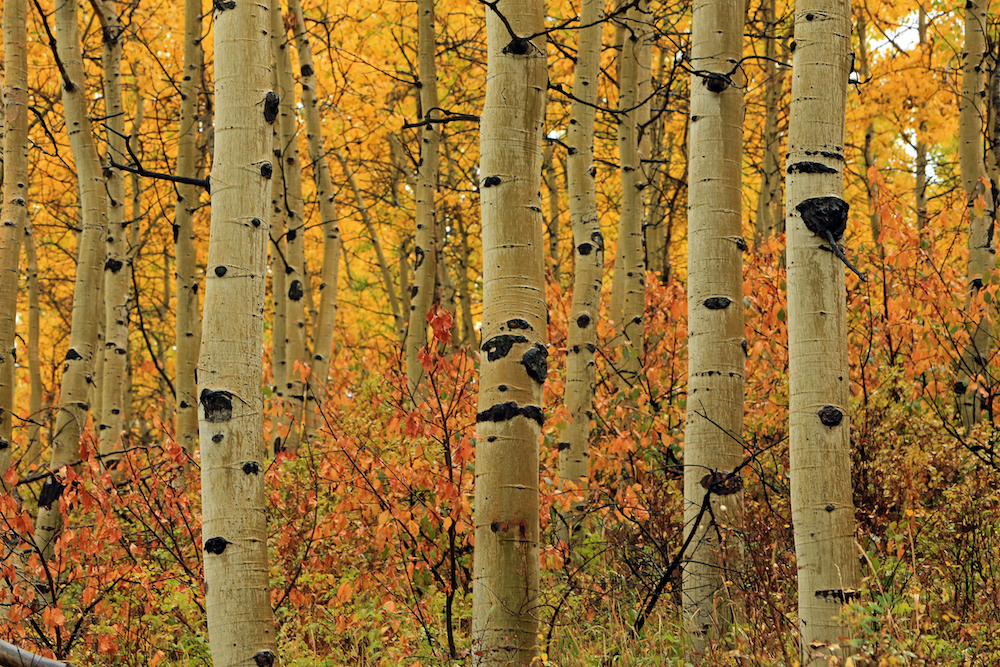
It's death by a thousand nibbles.
Pando, the world's largest living organism — and possibly its oldest — is being destroyed by the voracious appetite of mule deer.
Also known as the trembling giant, Pando is a colony of quaking aspen that spans 106 acres (43 hectares) of south-central Utah. Because of an explosion of deer in the area, new sprouts from Pando are eaten before they have a chance to mature, and the venerable organism is at risk of dying out altogether.
"The system is not replacing itself; it's highly out of balance," said Paul Rogers, an ecologist at Utah State University and the director of the Western Aspen Alliance. [See Photos of Earth's Oldest Living Things]
A forest of one tree
To the casual observer, Pando looks like an ordinary forest. But each tree shares a common root system and is a genetically identical clone of its forest pals. It's essentially a forest of one tree, Rogers said.
"What you all think of as trees are actually one living and connected being," Rogers told Live Science. "Being in this grove or this forest to me is pretty magical."
Though Pando has often been called the oldest living organism on Earth (with some estimates claiming the stand is upward of 80,000 years old), dating techniques for the colony are so imprecise that no one can say for sure how old the grove is, Rogers said.
Sign up for the Live Science daily newsletter now
Get the world’s most fascinating discoveries delivered straight to your inbox.
A closer look reveals that the majestic superorganism is in trouble. In short, Pando is aging fast.
"If we had a community of 50,000 people and every one of them was over 80 years of age, we wouldn't have a very sustainable community," Rogers said. "That is exactly what we're looking at with the Pando clone."
The reason is that mule deer, and occasionally cattle, are devouring the babies of the community before they have an opportunity to grow to maturity. The problem has been going on for decades, Rogers said.
"It's clear that nearly every sprout that comes up — they're technically called suckers — is eaten almost immediately as it comes out of the ground," Rogers said.
Meanwhile, the older stems are almost all between 110 and 130 years old, which is about the typical life span of individual quaking aspen stems, Rogers said. The forest floor is covered with dead trees, and no new life is coming in to replace it, he said.
Complicated problem
Mule deer and other herbivores became such a problem for Pando in recent decades in part because of humans.
"Humans have eliminated predators," Rogers said.
Without wolves prowling the area, for instance, deer populations not only explode, but the deer that do frequent an area become more brazen. Instead of moving on quickly, they linger and munch on the nutrient-rich sprouts to their hearts' content.
"It's akin to a salad bar or a candy store. It's very, very desirable to these herbivores," Rogers said.
What's more, because state wildlife agencies fund themselves in part by issuing hunting licenses, they have some incentive to keep the deer populations high, so hunters don't go home empty-handed, Rogers said. Finally, there are cabins near Pando, and one campground is located within the grove itself, Rogers said. Because hunting near human dwellings is prohibited, the deer tend to hang out in this area because they know they'll be safe from hunters, he added.
Cattle that come in from higher ground for a few weeks a year also pose problems, because they may trample or eat the shoots during those periods, Rogers said. [Quaking Aspen: Trees of the Mountain West]
Possible solutions
Pando is dying, but Rogers, along with others at the Western Aspen Alliance, an organization that works to promote healthy aspen ecosystems, are looking for ways to save the trembling giant. Cattle come through the area a few weeks a year, so persuading ranchers to take a slightly different route for those few weeks could help, he said.
In a study published in February in the journal Ecosphere, Rogers and his colleagues showed that fencing-in growing suckers had some success in preventing deer from eating them, as long as the suckers were actively protected until they were above "browsing" height of about 6 feet (2 meters). (Above this height, most mule deer aren't tall enough to easily eat these sprouts.)
However, deer sometimes manage to get through these fences, so the fencing strategy may need to be re-evaluated at some point, Rogers said.
Another possible solution is to hire trained professionals to cull (read: shoot) deer, Rogers said. Letting amateur hunters loose near human-occupied areas like campgrounds or cabins isn't safe, but professional sharpshooters are trained to do so safely.
It's possible, too, that culling just a few animals could have an outsize impact. Aspen have chemical defenses that leave a bad taste in animals' mouths, so the deer that are munching on Pando are likely just a handful of animals that have acquired adaptations that allow them to tolerate the taste, Rogers said.
"It's really actually not a big number that are chronically feeding on that area," Rogers said.
Rogers is working with several different agencies and interest groups to find ways to save Pando that everyone can live with.
"I'm optimistic," Rogers said.
Originally published on Live Science.

Tia is the managing editor and was previously a senior writer for Live Science. Her work has appeared in Scientific American, Wired.com and other outlets. She holds a master's degree in bioengineering from the University of Washington, a graduate certificate in science writing from UC Santa Cruz and a bachelor's degree in mechanical engineering from the University of Texas at Austin. Tia was part of a team at the Milwaukee Journal Sentinel that published the Empty Cradles series on preterm births, which won multiple awards, including the 2012 Casey Medal for Meritorious Journalism.










